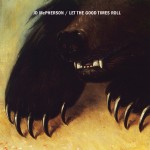“Let the Good Times Roll”
JD McPherson
Rounder Records
3.5/5 paws
Roots rocker JD McPherson’s sophomore release, “Let the Good Times Roll,” is a sonic time machine set for 1950s America, using the power of old-school tape echo and tremolo to transport the listener back to the birth period of rock ‘n’ roll. Listening to these songs through iPhone headphones almost seems sinful, as its lush production and warm analog background fuzz seek to envelop the listener in a warm embrace of guitar, rockabilly piano and the shake, rattle and stomp of bluesy drums, making it truly deserving of stereo play.
To some degree however, the album is almost too picturesque. At moments, it’s as if McPherson shoved the kind of knick-knacks found in a Ruby’s Diner, a few Little Richard albums and the cast of Grease into a blender, hit puree and threw back a shot of the resulting concoction.
Initially, his use of the era’s iconic recording techniques and trademark effects is taken to such an extreme that the album becomes a caricature of early rock ‘n’ roll instead of the homage that McPherson no doubt intends it to be. It takes a closer listening to notice that what first appears as laser-precise imitation of the ’50s sound is permeated with subtle risk-taking. In this sense, the album serves as the next stage in the progression of a genre that to many might be seen as having died long ago.
This extreme to which McPherson takes roots rock sets it apart from more traditional rockabilly. The effect-drenched nature of its songs gives “Let the Good Times Roll” an almost psychedelic feel. These songs certainly don’t seem to come from the same place inspirationally as mid-century music; the album’s title track is said to be the result of McPherson’s accidental use of expired Tylenol PM and his viewing of an episode of “Frasier.” He describes the incident as being surreal and frightening, which is ironic, as the track itself is jubilant and starts the album off running at a brisk and peppy pace.
“Let the sky open up and let the good times roll,” McPherson sings in his upbeat opener, “Let the Good Times Roll”, an ode to taking things as they come and never forgetting to enjoy oneself.
“It’s All Over but the Shouting” might be the best example of McPherson’s use of ’50s era recording techniques. The track utilizes tape echo, which, in combination with its southern blues rock vibe lends the impression of the song being tracked in a large church, a place with soul and beautiful, bouncy reverb.
Songs “Everybody Talking ‘bout The All-American” and “Bridge Builder,” the latter of which was written with the help of Dan Auerbach of the Black Keys, show the range of both McPherson and the rockabilly genre.
“The All-American” is a fast-paced pop-rocker, complete with horns and a classic “Louie Louie” chord progression. On the other hand, “Bridge Builder” sees McPherson finding his soft side and doing his best Sam Cooke crooning impression. Slow and sweet, the piano taps out a steady, high tempo for McPherson’s voice to waltz through.
“I’ll be something real and true, building bridges to you,” he sings. This is the slow dance from every ’50s period film, and it is pretty. More than pretty. The song proves to be a memorable moment in the album as a whole.
On both of these tracks, as it is throughout the album, McPherson’s voice is a treasure and on full display on this second studio release. At one moment, his voice is polished and smooth and packed with enough passion to command attention without having to yell for it. At the next, he is channeling the likes of Little Richard and James Brown, letting loose vocally, enough so to draw out the sort of classic analog mic distortion that’s practically synonymous with the era he is seeking to honor.
McPherson probably won’t be getting much radio playtime with this album. His risk-taking is a bit too subtle for the songs to be seen as a rehashing of something old, as opposed to something new that’s been derived from the old. That’s not to say it isn’t well worth the listen. McPherson’s desire to revive and revitalize the ’50s sound is both refreshing and thoroughly enjoyable and sets an interesting precedent for exploration with new eyes into forgotten musical landscapes. Rockabilly is back and as effective as ever, all thanks to one JD McPherson.
